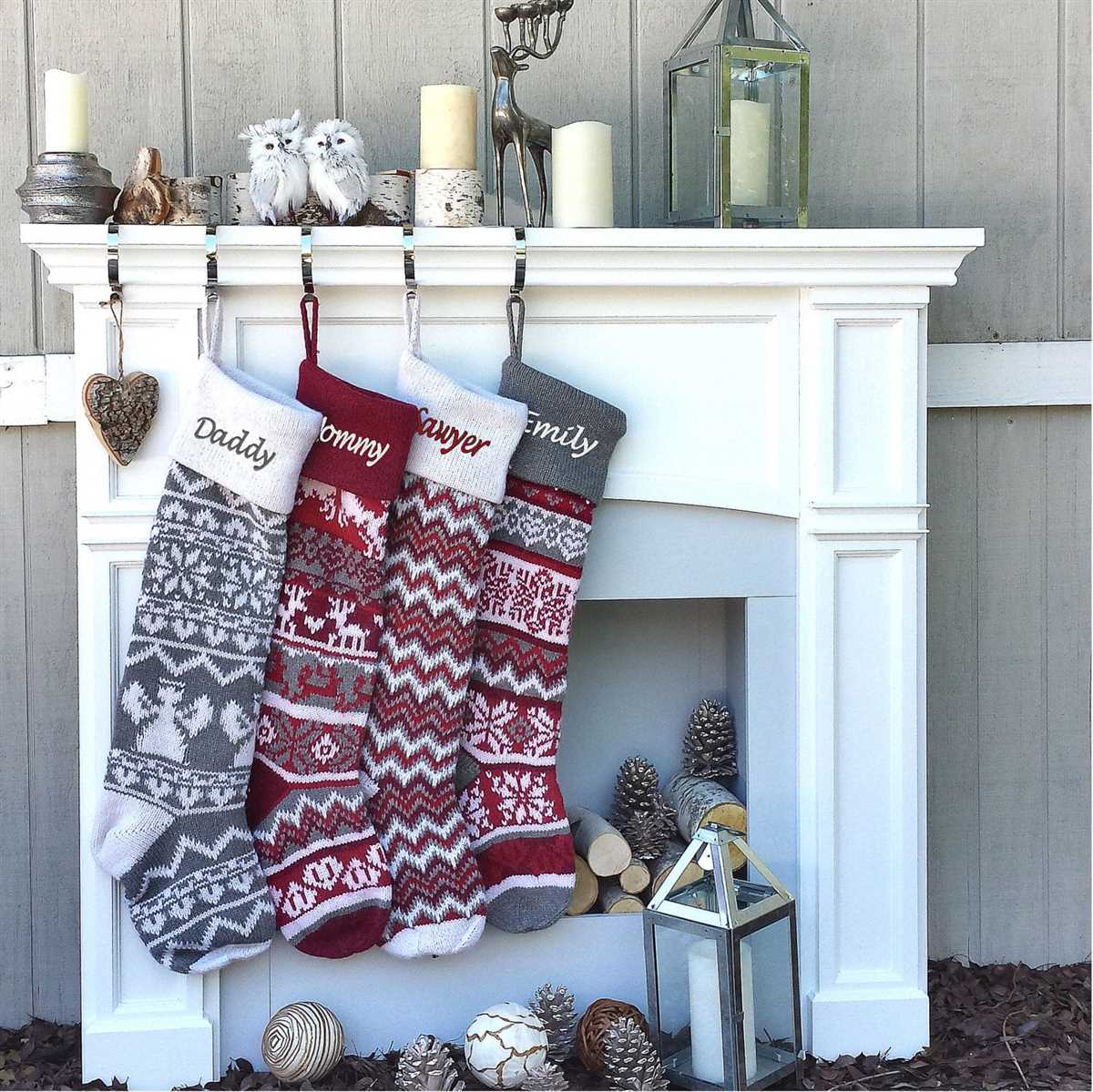
As the holiday season approaches, many knitters are eager to start working on festive projects to decorate their homes and surprise their loved ones. One popular item to knit during this time of year is a Christmas stocking. While there are many patterns available, knitting a large Christmas stocking can be a particularly enjoyable and rewarding project.
A large Christmas stocking offers ample space for gifts and treats, making it the perfect addition to any fireplace or staircase. Additionally, the size allows for more intricate designs and patterns, giving knitters the opportunity to showcase their skills and creativity. Whether you prefer classic holiday motifs or modern and bold designs, a large Christmas stocking is a great canvas to experiment with different stitches and techniques.
If you’re interested in knitting a large Christmas stocking, there are plenty of patterns available to suit your style and skill level. From simple stripes and Fair Isle patterns to intricate cables and lacework, there’s something for everyone. Not only will knitting a large Christmas stocking be a fun and engaging project, but the end result will be a cherished keepsake that can be passed down through generations.
What is a Christmas Stocking and Why Do We Hang Them?
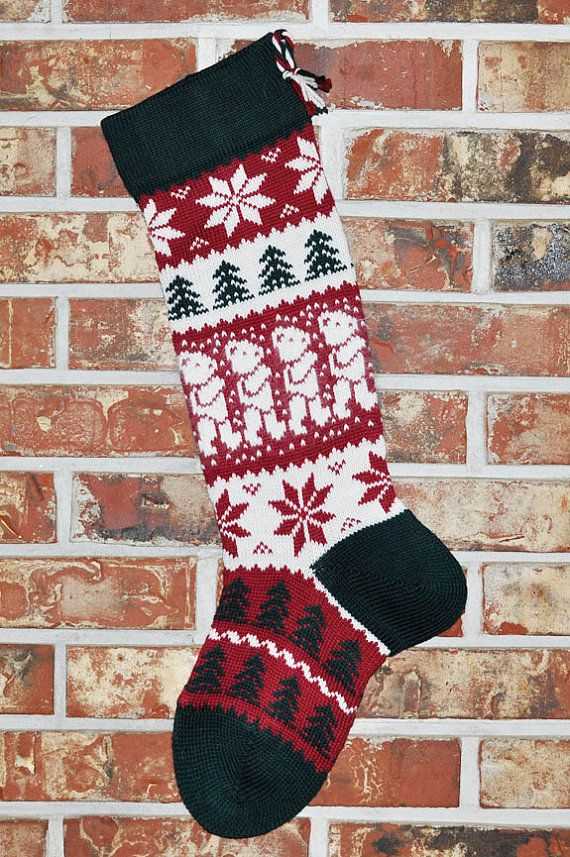
A Christmas stocking is a large sock-shaped bag or pouch that is traditionally hung up on Christmas Eve for Santa Claus to fill with gifts. It is a popular Christmas tradition in many countries, particularly in Western cultures. The stockings are usually hung by the fireplace or on a mantel, but they can also be hung on a bedpost, doorknob, or any other convenient place.
The origin of the Christmas stocking tradition can be traced back to the legend of St. Nicholas, who would secretly give gifts to those in need. According to the legend, St. Nicholas heard about a widowed man who was struggling to provide for his three daughters. In order to help them, St. Nicholas decided to anonymously give them money. He threw three bags of gold coins through the window, and they landed in the stockings that were hung by the fireplace to dry. This act of kindness became the inspiration for the tradition of hanging stockings and receiving gifts on Christmas.
The stockings themselves are often decorative and personalized, with each family member having their own stocking. They can be knitted, crocheted, or made from fabric, and are often embellished with ribbons, lace, or embroidery. Some families even have heirloom stockings that have been passed down from generation to generation.
On Christmas Eve, children are encouraged to hang their stockings and leave them out for Santa Claus. The belief is that Santa Claus will visit during the night and fill the stockings with small gifts, treats, and goodies. The excitement of waking up on Christmas morning and discovering what surprises are inside the stocking is a cherished part of the holiday for many children.
Overall, the tradition of hanging Christmas stockings is a way to bring joy, excitement, and anticipation to the holiday season. It is a symbol of generosity and the spirit of giving, as well as a reminder of the joy and wonder of childhood. Whether store-bought or handmade, the Christmas stocking is a beloved tradition that continues to bring smiles to faces on Christmas morning.
The Tradition of Knitting Christmas Stockings
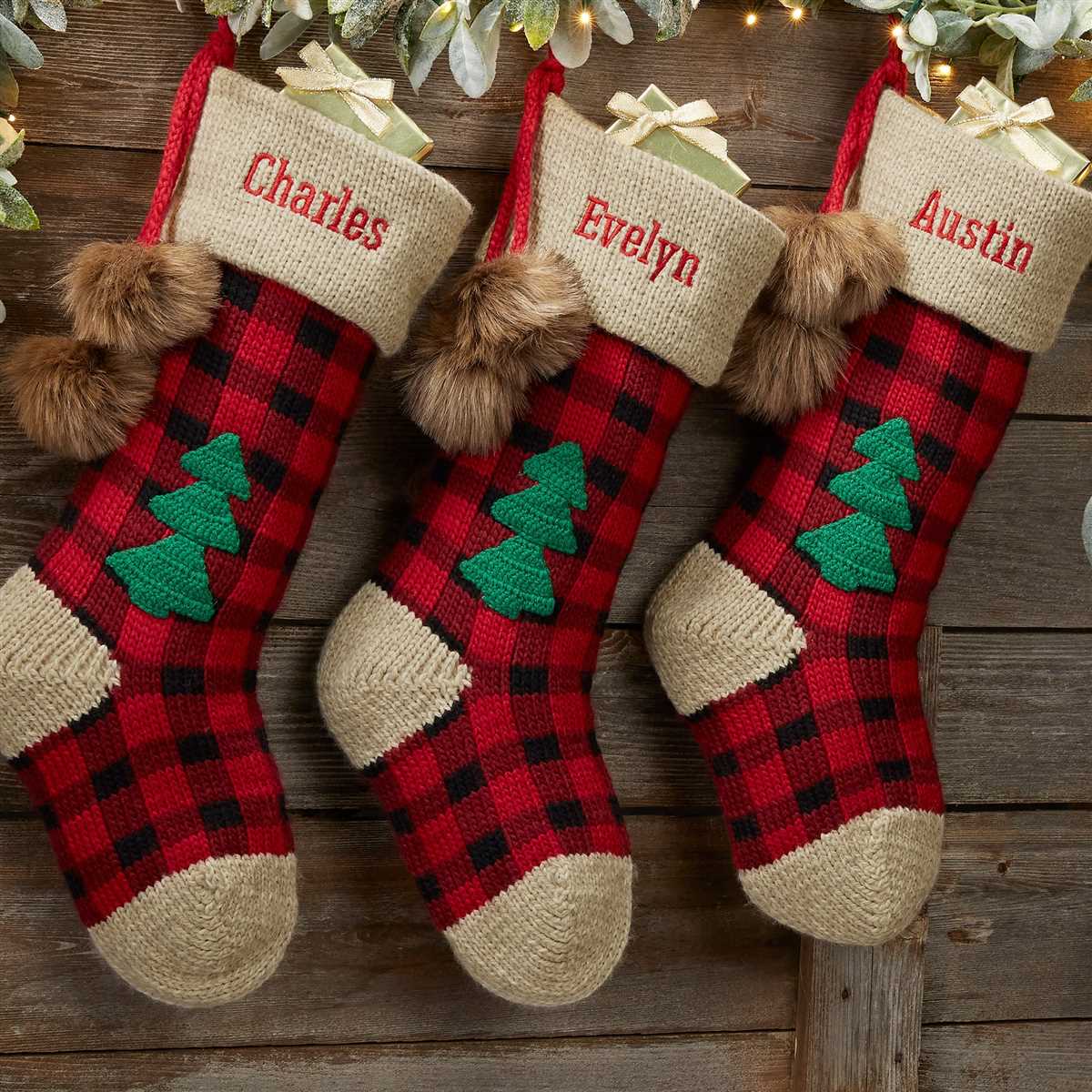
Christmas stockings have long been a beloved symbol of the holiday season. One tradition that has been passed down through the generations is the art of knitting these stockings by hand. Knitting Christmas stockings is not only a creative and enjoyable activity, but it also holds deep sentimental value for many families.
Knitting Christmas stockings allows individuals to personalize each stocking with unique colors, patterns, and designs. Families often choose specific themes or motifs for their stockings, such as snowflakes, reindeer, or Santa Claus. Some may even incorporate the initials of each family member to ensure that everyone has their own special stocking hanging by the fireplace.
The process of knitting a Christmas stocking requires time, patience, and skill. Knitters must carefully select the appropriate yarn and needles, ensuring that the stocking will be both sturdy and comfortable. The pattern chosen for the stocking will vary depending on the desired size and style. Some stockings may feature intricate cable designs, while others may be more simple and classic in nature.
Once the knitting is complete, finishing touches such as adding a fluffy pom-pom or decorative trim can be added to make each stocking truly unique. The final result is a beautiful and cherished item that can be passed down through the generations, becoming a treasured part of each family’s Christmas traditions.
History and Origins
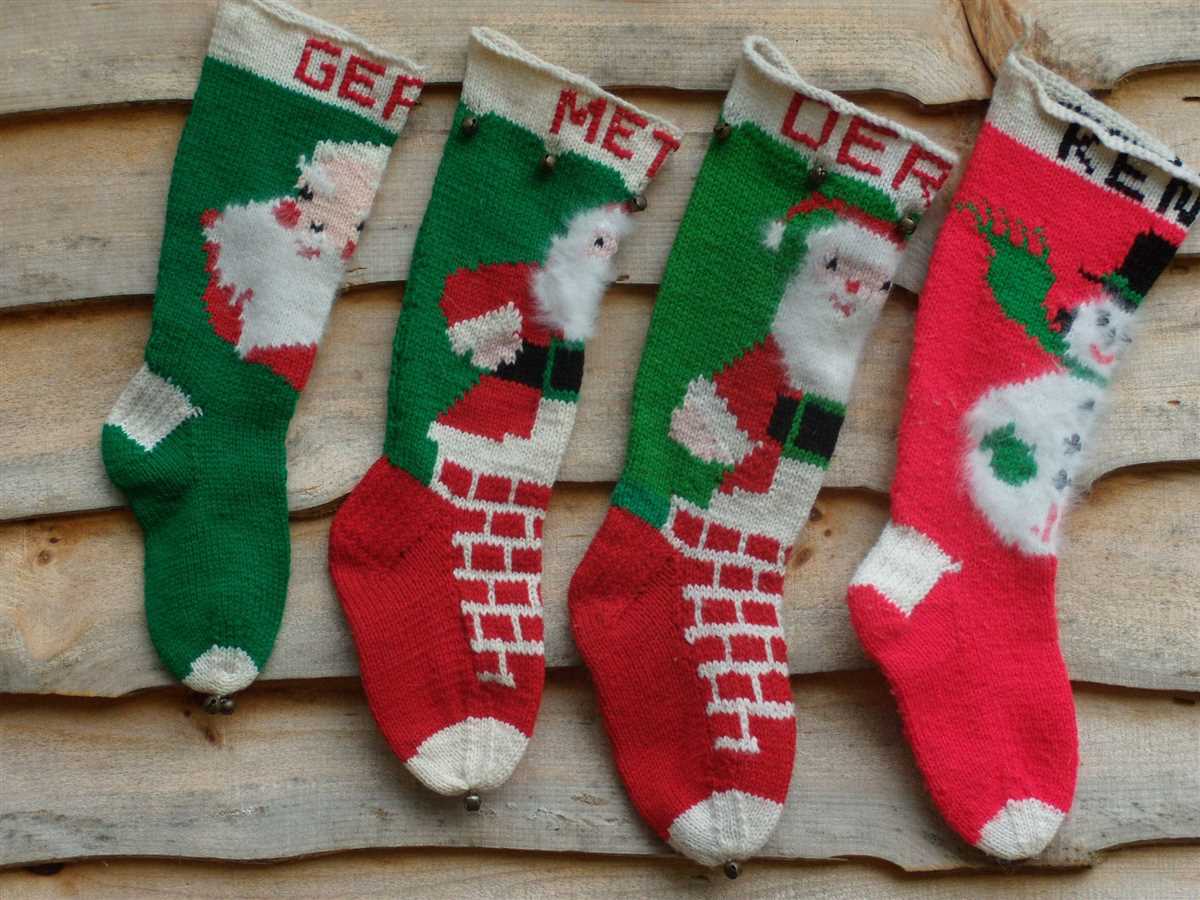
The tradition of hanging stockings and filling them with gifts during Christmas has a long history that dates back to several centuries. One of the most popular theories about the origins of this tradition traces it back to the story of St. Nicholas. According to the legend, St. Nicholas wanted to help a poor man and his three daughters. He knew that the man had no money to provide dowries for his daughters, which meant they would likely remain unmarried. St. Nicholas decided to secretly help the family by throwing bags of gold through the chimney, which landed in the stockings that were hanging by the fireplace to dry. The daughters woke up the next morning to find the bags of gold in their stockings, and this act of generosity became the basis for the tradition of hanging stockings on Christmas Eve.
While the story of St. Nicholas is often cited as the origin of the tradition, hanging stockings during Christmas is also believed to have ancient roots. In ancient Rome, people would hang socks filled with gifts during the festival of Saturnalia, which was a celebration of the winter solstice. This tradition was later adopted by Christians as a way to commemorate the generosity of St. Nicholas and to symbolize the gifts of the three wise men to baby Jesus.
Today, the tradition of hanging stockings on Christmas Eve is widely practiced around the world. Different cultures and regions have their own variations of the tradition. Some people use large Christmas stockings that can be filled with larger gifts, while others prefer smaller stockings that are hung on a mantel or staircase. Knitting your own large Christmas stocking is a popular DIY project that allows you to personalize the stocking with unique patterns and designs. Whether you follow a traditional knitting pattern or create your own, knitting a large Christmas stocking can be a fun and rewarding activity that adds a personal touch to your holiday decor.
Why Knit a Christmas Stocking?
Knitting a Christmas stocking is a wonderful way to add a personal touch to your holiday decorations. Instead of purchasing a generic stocking from a store, knitting your own allows you to create a one-of-a-kind piece. It’s a chance to showcase your knitting skills and creativity, and produce something that is truly unique and special.
Knitting a Christmas stocking also allows you to customize it to fit your personal style and the theme of your holiday decor. Whether you prefer traditional patterns or modern designs, you can find or create a knitting pattern that suits your taste. You can choose the colors, textures, and embellishments that resonate with you and reflect the festive spirit of Christmas.
When you knit a Christmas stocking, it becomes more than just a decorative item. It becomes a meaningful heirloom that can be passed down through generations. Handmade gifts have a special significance and are often cherished more than store-bought ones. Knitting a stocking for a loved one or a friend is a way to show them how much you care and to create a lasting memory of the holiday season.
Furthermore, knitting is a relaxing and therapeutic activity. Engaging in this craft can help reduce stress, improve focus, and promote mindfulness. During the busy holiday season, taking time to knit can provide a peaceful and enjoyable escape from the hustle and bustle. It allows you to slow down, unwind, and create something beautiful in the process.
In conclusion, knitting a Christmas stocking is a rewarding and meaningful project. It allows you to add a personal touch to your holiday decorations, create a unique and customizable piece, and give a thoughtful and cherished gift to your loved ones. So, grab your knitting needles and get ready to bring the festive spirit to life with a beautiful, hand-knit Christmas stocking.
Choosing the Right Yarn and Needles
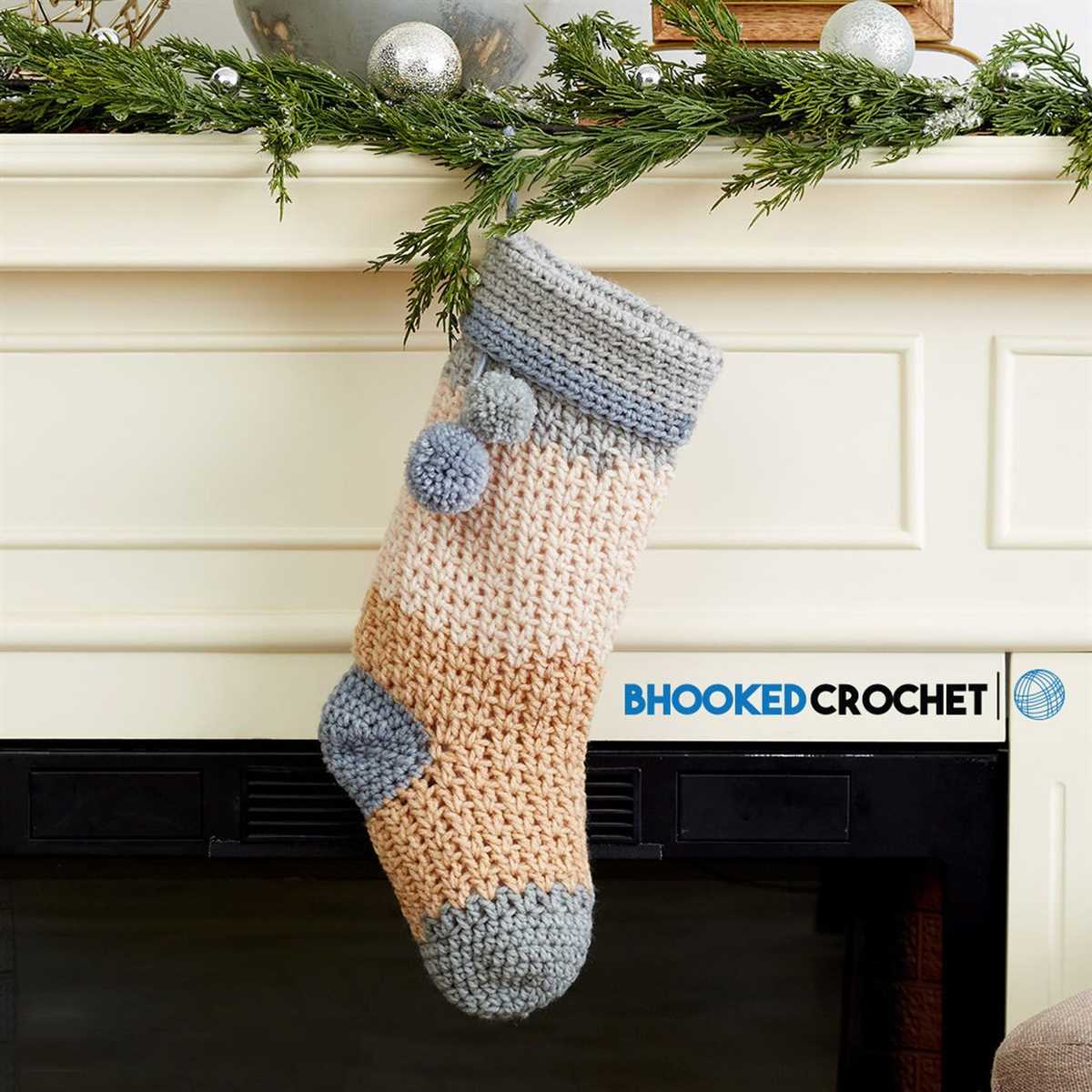
When it comes to knitting a large Christmas stocking, choosing the right yarn and needles is essential. The yarn you choose will determine the texture, thickness, and overall appearance of the stocking. It’s important to consider the recipient’s preferences and the desired outcome when selecting a yarn.
Yarn Weight: The weight of the yarn refers to its thickness. For a large Christmas stocking, a medium to bulky weight yarn is ideal as it will create a thicker fabric. This will help the stocking hold its shape and provide warmth. However, you can also opt for lighter weight yarns if you prefer a more delicate look.
Fiber Content: The fiber content of the yarn will also affect the stocking’s appearance and feel. Acrylic yarns are a popular choice for Christmas stockings as they are affordable, easy to care for, and come in a variety of colors. However, natural fibers like wool or cotton can add a touch of luxury and warmth to the stocking.
Color and Design: Consider the recipient’s favorite colors and the overall theme of your Christmas decor when choosing the yarn color. You can go for traditional Christmas colors like red, green, or white, or get creative with unique color combinations. Additionally, some yarns come with self-striping or variegated patterns, which can add extra visual interest to your stocking.
Needle Size: The size of the needles you use will affect the gauge of your knitting and the final size of the stocking. Before starting your project, check the yarn label for the recommended needle size. If you want a tighter stitch and a denser fabric, use smaller needles. Alternatively, larger needles will create a looser, more open stitch pattern.
Gauge: It’s important to check your gauge before starting the project to ensure the stocking will turn out to be the desired size. To do this, knit a small swatch using your chosen yarn and needles. Measure the swatch and compare it to the gauge specified in the pattern. If your gauge doesn’t match, adjust your needle size accordingly.
To summarize, when knitting a large Christmas stocking, choose a yarn weight and fiber content that align with the desired outcome and recipient’s preferences. Consider the colors and design elements that will complement your Christmas decor. Finally, check your gauge and use the appropriate needle size to ensure the stocking turns out to be the right size.
Essential Knitting Stitches for a Large Christmas Stocking
When knitting a large Christmas stocking, it’s important to choose the right stitches to create a beautiful and festive design. Here are some essential knitting stitches that will add texture and interest to your stocking:
1. Stockinette Stitch:
The stockinette stitch is one of the most basic and versatile stitches in knitting. It creates a smooth, flat fabric with a “v” pattern on the right side. You can use the stockinette stitch for the body of the stocking to give it a clean and polished look.
2. Cable Stitch:
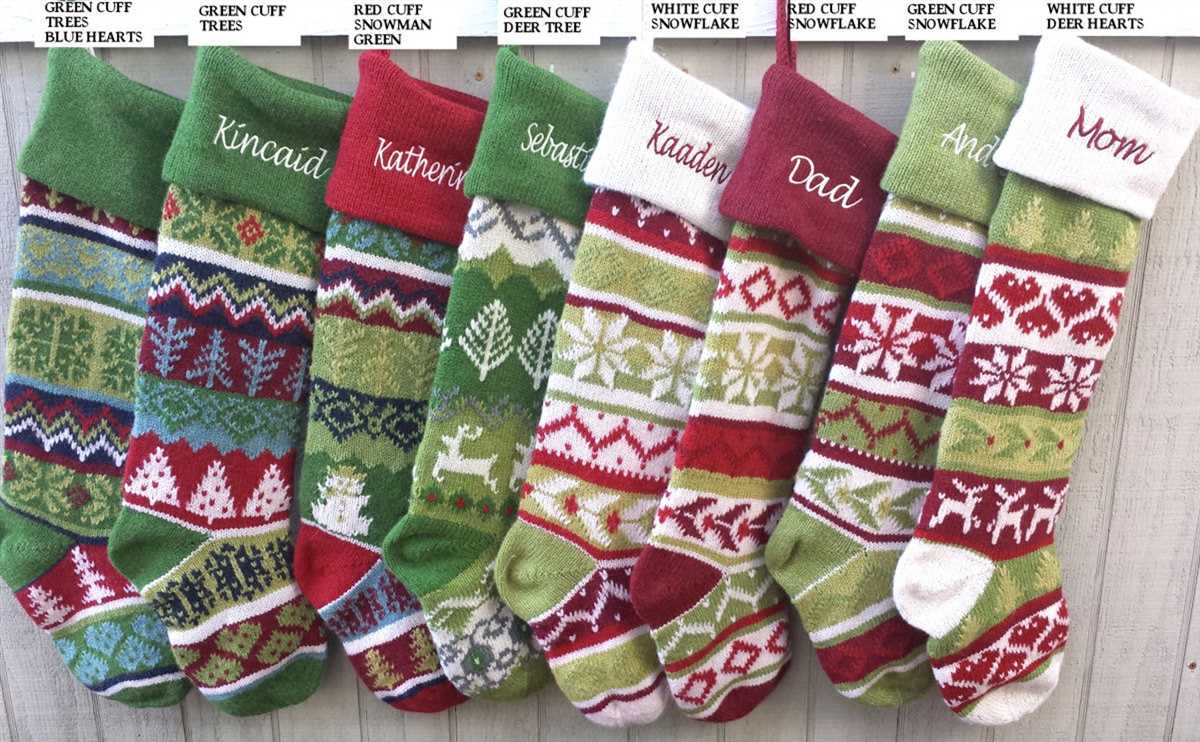
The cable stitch adds a classic and decorative element to your knitting project. It involves crossing stitches over each other to create a twisted cable effect. You can use the cable stitch to create intricate designs and patterns on the front of the stocking, such as braids or intertwining cables.
3. Seed Stitch:
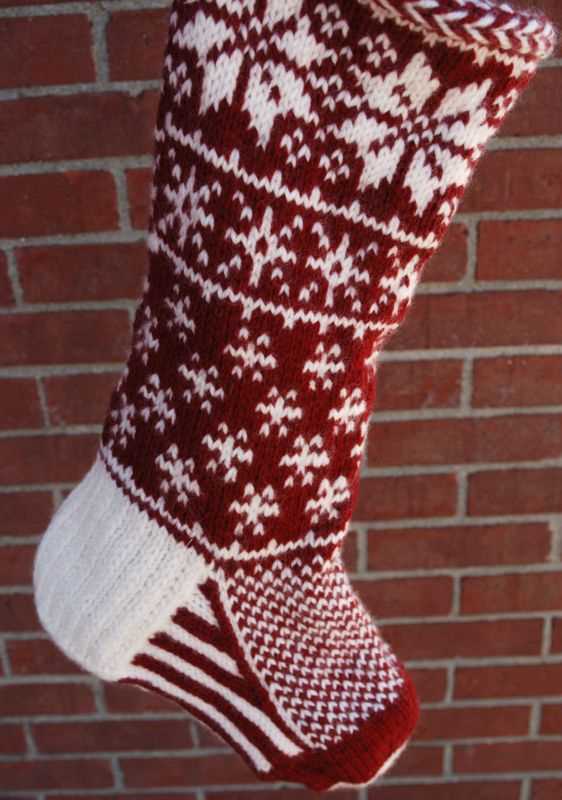
The seed stitch is a great stitch for adding texture and interest to your knitting. It creates a bumpy, pebbled pattern that looks like scattered seeds. The seed stitch can be used for the cuff or the toe of the stocking to give it a unique and eye-catching look.
4. Rib Stitch:
The rib stitch is a popular choice for creating stretchy and snug-fitting fabric. It is often used for ribbed cuffs, collars, and borders. You can use the rib stitch for the top and the bottom of the stocking to ensure that it stays in place and fits nicely.
Incorporating these essential knitting stitches into your large Christmas stocking will not only add visual interest but also enhance the overall design. Experiment with different stitch combinations and patterns to create a stocking that is unique and personalized for your loved ones. Happy knitting!
Rib Stitch
The rib stitch is a classic knitting pattern that creates a textured fabric with alternating columns of knits and purls. It is commonly used for cuffs, collars, and bands as it has a lot of stretch and helps the edges maintain their shape. The rib stitch is also a popular choice for sweaters, scarves, and hats as it adds visual interest and a bit of elasticity to the fabric.
To create the rib stitch, you will need to know how to knit and purl. The basic pattern consists of a series of knit stitches followed by a series of purl stitches, and then repeating these two rows. You can adjust the width of the ribs by changing the number of knit and purl stitches in each row.
To knit the rib stitch, you will start by casting on an even number of stitches. Then, on the first row, you will knit the first stitch, purl the next stitch, and continue this pattern across the row. On the second row, you will purl the first stitch, knit the next stitch, and continue this pattern across the row. Repeat these two rows until you have reached the desired length.
The rib stitch is a versatile pattern that can be used in various knitting projects. Whether you’re knitting a cozy sweater or a festive Christmas stocking, the rib stitch is a great choice for adding texture and stretch to your fabric.
Cable Stitch
The cable stitch is a popular knitting technique that creates a decorative pattern resembling intertwined cables. It is commonly used in various knitting projects, including large Christmas stockings. The cable stitch adds texture and visual interest to the stocking, making it an attractive and unique piece.
To create the cable stitch, you will need a cable needle. This needle is used to hold a section of stitches while you work on another section. It is essential to keep track of where you are in the pattern to create the correct cable design. Following a cable stitch chart or written instructions can help guide you through the process.
There are different types of cable stitches, such as the basic cable, twisted cable, and braided cable. Each variation creates a different pattern and adds its own charm to the knitting project. You can also experiment with different cable stitch combinations to create your unique designs.
When knitting a large Christmas stocking with cable stitches, it is essential to plan the placement of the cables carefully. You can choose to have one or multiple cables running along the body of the stocking or have them positioned on the cuff or toe. The choice of yarn color can also enhance the cable stitch pattern and make it stand out.
- To create a large Christmas stocking with cable stitch, follow these steps:
- Choose a cable stitch pattern and decide on the placement.
- Calculate the number of stitches required for the stocking.
- Cast on the desired number of stitches and begin knitting the stocking in the round.
- Follow the cable stitch chart or written instructions to create the cable pattern.
- Continue knitting until the stocking reaches the desired length.
- Work the heel and toe sections of the stocking.
- Finish off the stocking with a ribbed cuff and bind off.
- Add any additional decorations or embroidery to personalize the stocking.
Fair Isle Stitch
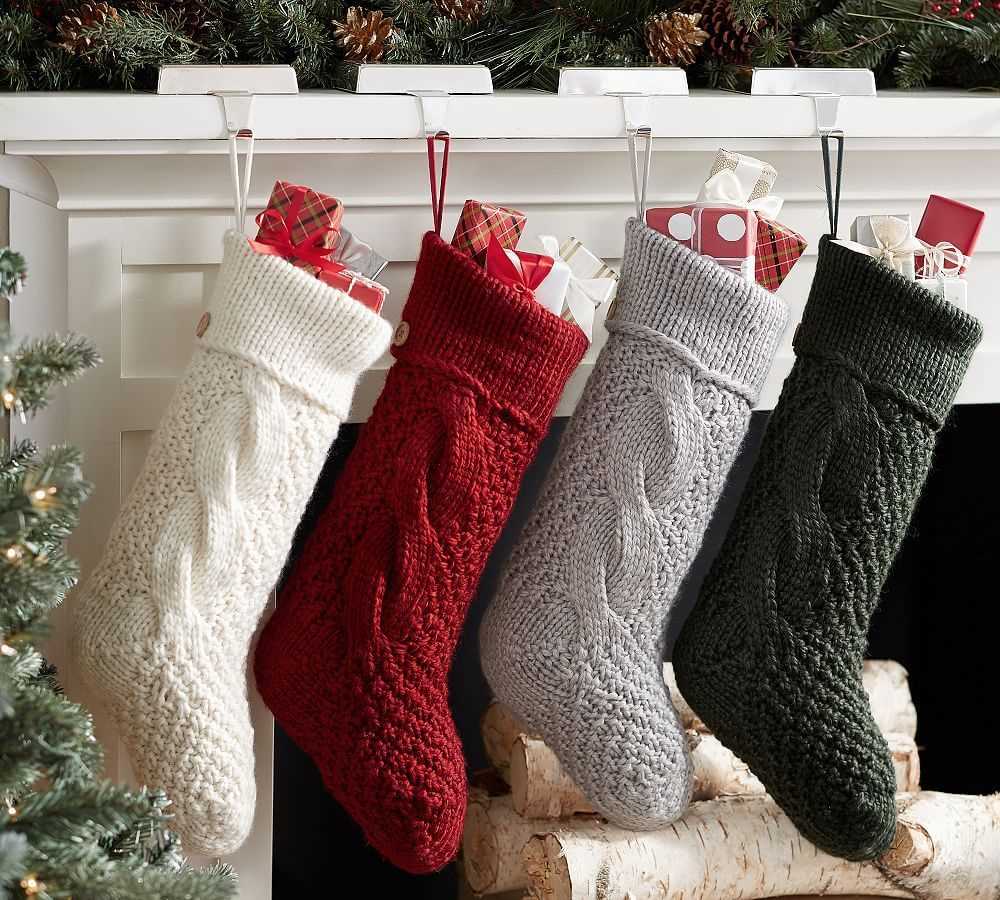
The Fair Isle stitch is a traditional knitting technique that originated in the Fair Isle, a small island in Scotland. It is characterized by its intricate colorwork patterns, which typically include multiple colors in a single row or round of knitting. The technique involves carrying the yarns not in use along the back of the work, creating floats on the wrong side of the fabric. These floats are then caught every few stitches to prevent them from becoming too long. This technique creates a beautiful and unique texture and can be used to create a wide range of designs.
To knit the Fair Isle stitch, you will need to use multiple colors of yarn. The pattern is typically charted, with each color represented by a different symbol or color. You will need to follow the chart and switch colors as indicated. When switching colors, you will need to carry the unused yarn along the back of the work, catching it every few stitches to prevent long floats. It is important to maintain an even tension and to avoid carrying the yarn too tightly, as this can cause the fabric to pucker.
The Fair Isle stitch is commonly used in traditional knitting patterns, such as the large Christmas stocking. The intricate colorwork adds a festive touch to the stocking and allows for endless design possibilities. Whether you choose to incorporate classic holiday motifs or create your own unique pattern, the Fair Isle stitch will create a stunning and eye-catching stocking that is sure to impress. So grab your knitting needles and colorful yarns, and get ready to create a beautiful piece of holiday decor with the Fair Isle stitch!
Knitting a Large Christmas Stocking: Step-by-Step Instructions
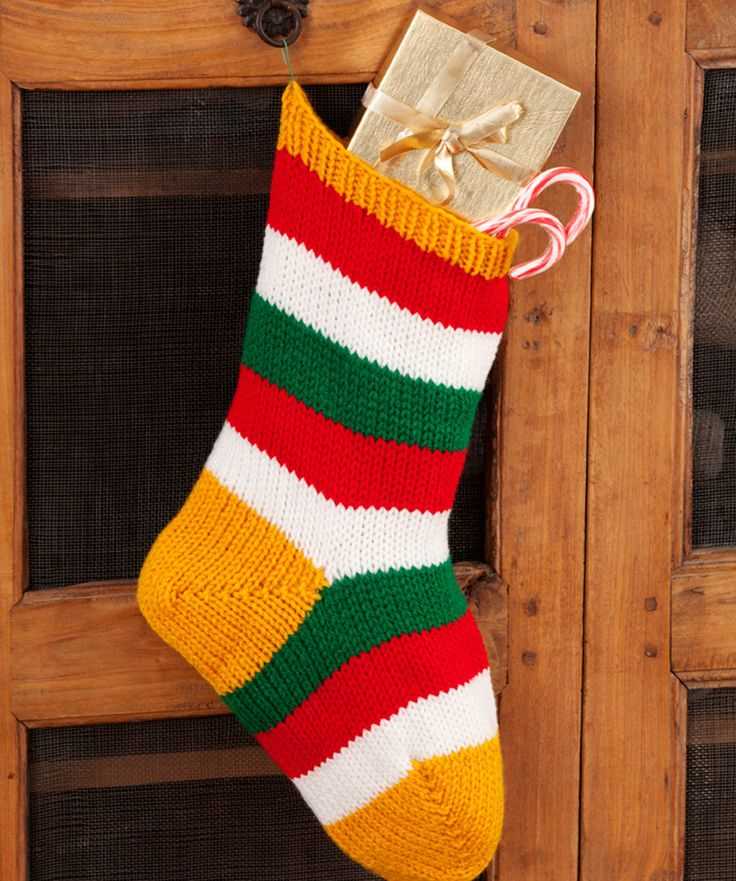
Knitting a large Christmas stocking can be a fun and festive project to add a personal touch to your holiday decorations. Whether you’re a beginner or an experienced knitter, this step-by-step tutorial will guide you through the process of creating a beautiful and spacious stocking that will be perfect for stuffing with treats and surprises.
Materials needed:
- Chunky yarn in your choice of colors
- Knitting needles in size appropriate for your yarn
- Tapestry needle
- Scissors
- Optional: decorative embellishments such as pom-poms or bells
Step 1: Cast on
Begin by casting on stitches to create the top cuff of your stocking. You can choose any number of stitches depending on how wide you want the cuff to be. A good starting point is around 40 stitches, but you can adjust this to fit your desired size.
Step 2: Knit in the round
Once you have cast on your stitches, join them in the round using either the magic loop method or double-pointed needles. Knit every round until your cuff is the desired length, typically around 4-6 inches.
Step 3: Switch colors (optional)
If you want to add a contrasting color to your stocking, this is the time to switch yarns. Simply cut your current yarn, leaving a tail to weave in later, and join the new color. Continue knitting in the round until the stocking is the desired length.
Step 4: Shape the toe
To shape the toe of the stocking, you will need to decrease stitches. This can be done using various decrease methods such as knit two together (k2tog) or slip slip knit (ssk). Follow a decreasing pattern until you have a few stitches remaining.
Step 5: Finish the toe
Once you have decreased enough stitches, cut the yarn, leaving a long tail. Thread the tail through a tapestry needle and slip it through the remaining stitches, pulling tight to close the toe. Secure the end by weaving it in.
Step 6: Finishing touches
With the main body of the stocking complete, you can now add any decorative embellishments you desire. This could include attaching pom-poms, bells, or even a personalized name tag. Let your creativity shine!
Follow these step-by-step instructions to create your own large Christmas stocking and enjoy the process of knitting something special for the holiday season. Hang it by the fireplace or use it as a centerpiece for your festive decor – the choice is yours!
Cast On and Knit the Cuff
The first step in knitting a large Christmas stocking is to cast on the required number of stitches. You can use a long-tail cast on method, which provides a neat and stretchy edge for the cuff. Measure the circumference of the stocking cuff and multiply it by the number of stitches per inch to determine the total number of stitches needed. Make sure to leave a long tail when casting on, as this will be used later to sew the cuff seam.
Once you have cast on the stitches, it’s time to knit the cuff. The cuff is typically knitted in a ribbed pattern, such as k2, p2, to create an elastic and decorative edge. Knit each row in the ribbed pattern until the cuff reaches the desired length. To ensure an even tension, make sure to knit the stitches with a consistent tension and avoid pulling the yarn too tight or leaving it too loose.
Knit the Body of the Stocking

Once you have finished knitting the cuff of your large Christmas stocking, it’s time to move on to the body. The body of the stocking is where you can get creative and add your own personal touch. You can choose to knit the body in a solid color or experiment with different patterns and designs.
To knit the body of the stocking, you will need to continue using your chosen yarn and knitting needles. Start by picking up stitches along the edge of the cuff, making sure to distribute them evenly. You can use double-pointed needles or switch to circular needles if you prefer.
Option 1: Solid Color Body
If you prefer a simple and classic look, knitting the body of the stocking in a solid color is a great choice. Simply continue knitting in your chosen color until you reach the desired length for the body. To add some texture, you can experiment with different stitch patterns such as seed stitch or ribbing.
Option 2: Fair Isle Design
If you’re feeling more adventurous, you can try knitting the body of the stocking with a Fair Isle design. Fair Isle is a technique that involves knitting with multiple colors at once to create beautiful patterns. You can choose a festive pattern with Christmas motifs or create your own unique design. Remember to carry the unused yarn along the back of your work to avoid loose strands.
Option 3: Stripes or Color Blocks
If you want to add some vibrant colors to your stocking, consider knitting the body in stripes or color blocks. You can alternate between two or more colors, creating horizontal stripes or vertical blocks. This is a great way to use up leftover yarn or create a visually appealing pattern.
Regardless of the design you choose, make sure to keep track of your pattern if you’re using multiple colors or stitch patterns. You can use stitch markers or a row counter to help you stay organized. Once you’re happy with the length of the body, you can move on to knitting the toe of the stocking.
Shape the Toe
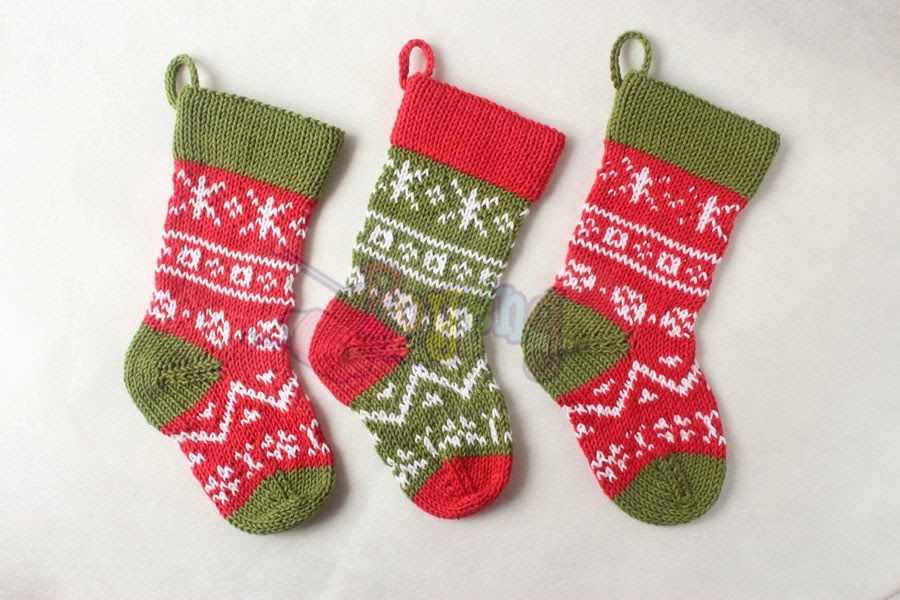
Once you have completed the desired length of your Christmas stocking, it’s time to shape the toe. This is done by decreasing stitches gradually to create a pointed shape.
Here is a simple method to shape the toe:
- Knit across the first row.
- On the next row, knit 2 stitches together at the beginning and end of the row.
- Continue knitting across the following row.
- Repeat steps 2 and 3 until you have decreased the desired number of stitches.
It is important to evenly distribute the decreases throughout the toe to ensure a well-shaped stocking. You can adjust the frequency of decreases depending on your desired toe shape.
Once you have decreased the stitches, bind off all remaining stitches. Remember to leave a long tail for seaming the toe together when you finish knitting.
And voila! You have completed knitting your large Christmas stocking. Now you can personalize it with decorations, names, or any other embellishments to make it truly unique.
Happy knitting and Merry Christmas!